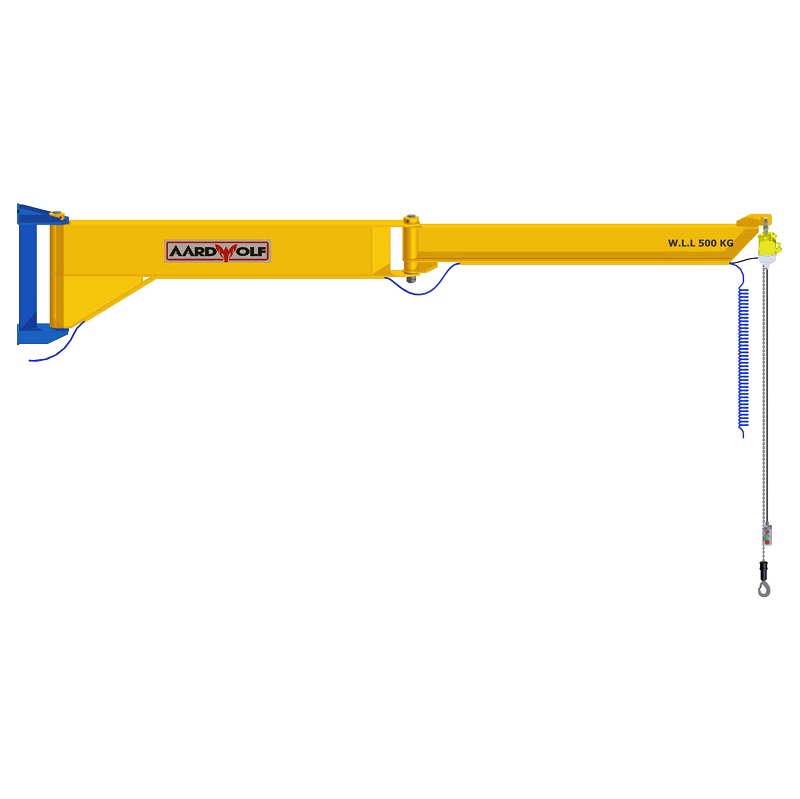Jib cranes are among the most adaptable lifting solutions available today. With their ability to rotate and operate in confined areas, they play a key role in industries that demand safe, efficient, and precise material handling. But where exactly is jib crane used? And how are different types—like freestanding, mast-type, mast mounted, wall-mounted, and articulating jib cranes—applied?
In this article, we’ll explore the most common applications of jib crane across sectors, highlight best practices, and emphasize the value of proper installation and safety compliance.
🔧 Looking for industrial lifting solutions? Check out jib crane products from Aardwolf.
Table of Contents
ToggleWhat Is a Jib Crane?
A jib crane is a lifting device that features a horizontal arm (the jib or boom) that supports a hoist. It can be floor-mounted or wall-mounted and is designed for repetitive, localized lifting tasks within a defined arc—typically between 180° and 360°. Because of their compact footprint and ease of use, jib cranes are used in environments where larger overhead cranes may be impractical.
Jib Crane Types and Their Applications
Choosing the right crane depends heavily on your facility’s layout, lifting needs, and material flow.
1. Freestanding Jib Crane
Application: Warehousing, outdoor yards, maintenance bays
- Mounted on a concrete foundation
- Offers 360° rotation
- Handles heavy loads (up to 5 tons)
- Ideal for outdoor and open indoor environments
2. Wall-Mounted Jib Crane
Application: Assembly lines, workstations, shipping areas
- Attached to building columns or structural walls
- 180°–200° rotation
- Saves floor space
- Ideal for repetitive tasks at fixed points
3. Mast-Type Jib Crane
Application: High-ceiling facilities, areas where anchoring to ceiling is allowed
- Supported between floor and ceiling
- No need for foundation bolts
- Offers 360° rotation
4. Mast Mounted Jib Crane
Application: Facilities with available structural support at ceiling and floor
- Provides full rotation
- Customizable boom lengths and capacities
- Used in heavy-duty manufacturing and maintenance areas
5. Articulating Jib Crane
Application: Confined areas, equipment servicing, tight workspaces
- Dual-arm design enables motion around corners or obstacles
- Highly flexible
- Ideal for delicate or high-precision load handling
Where Jib Cranes Are Used Most
1. Manufacturing Plants
From component loading to machine tool support, manufacturing operations use jib cranes to improve ergonomics and reduce downtime. Freestanding and wall-mounted types are popular in machine cells and welding stations.
⚠️ Planning a new crane? Avoid these Jib Crane Installation Errors That Can Lead to Downtime.
2. Warehouses & Distribution Centers
In loading and unloading zones, jib cranes handle boxes, pallets, drums, and equipment with precision. Their installation near conveyor belts or truck bays streamlines movement and improves workflow.
3. Construction and Fabrication Yards
Outdoor freestanding jib cranes are often used to lift heavy steel beams, precast concrete slabs, or other bulky items. Rugged construction and large rotation range make them ideal for tough conditions.
4. Automotive & Aerospace
Articulating jib cranes and mast-type cranes are favored in work cells where delicate components like engine blocks, frames, and fuselage panels need precise positioning.
📘 For industry-specific insights, see Jib Crane Applications: Top Industries That Rely on Them
5. Maintenance Shops and Garages
Whether servicing large pumps, HVAC units, or heavy tools, maintenance teams rely on jib cranes for safe, consistent lifting. Wall-mounted cranes are commonly installed over repair benches or diagnostic areas.
6. Marine and Shipyards
In marine facilities, mast-mounted or freestanding cranes are used to handle boat engines, deck components, and docking supplies. Their resistance to corrosion and ability to function outdoors is essential.
7. Pharmaceutical & Food Production
Sanitary-grade jib cranes—often made of stainless steel—are used in cleanroom environments to move process containers, packaging materials, and equipment.
Why Industries Choose Jib Cranes
| Benefit | Impact in Application |
|---|---|
| Compact Design | Fits tight areas and maximizes workspace |
| Localized Control | Enhances safety and precision in confined zones |
| Fast Installation | Quick deployment compared to overhead cranes |
| Affordable Operation | Low maintenance and minimal energy consumption |
| Versatile Configuration | Customizable swing arc, boom length, and hoist type |
Load Safety and Limitations
No matter the industry, adhering to load limits is critical. Overloading can result in equipment failure or injury.
- Each crane type has its rated capacity, based on boom length, pivot configuration, and mounting type.
- Dynamic loads (swinging, rotating under weight) can increase stress.
🛡️ Read Jib Crane Load Limits & Safety Tips You Shouldn’t Ignore to avoid costly mistakes.
Choosing the Right Jib Crane for Your Application
Here’s a quick reference chart to help match crane types with application needs:
| Application Area | Recommended Crane Type |
|---|---|
| Assembly line | Wall-mounted or articulating |
| Shipping & receiving | Mast-type or freestanding |
| Outdoor fabrication | Freestanding |
| Machine service area | Articulating |
| Food-grade environments | Stainless steel jib crane |
| Compact workshop corners | Articulating |
Final Thoughts: Match Purpose to Performance
From precision assembly in cleanrooms to outdoor slab handling in a concrete yard, jib cranes are essential to modern industry. Their adaptability, compact footprint, and localized lifting capabilities make them ideal for a wide variety of tasks and workspaces.
But success depends on planning. Always assess site constraints, load requirements, and future workflow changes before selecting and installing a jib crane.
📦 Shop smarter. View jib crane products that match your exact needs.
Related Articles:
- Jib Crane Installation Errors That Can Lead to Downtime
- Jib Crane Load Limits & Safety Tips You Shouldn’t Ignore
- Jib Crane Applications: Top Industries That Rely on Them
Reliable lifting starts with the right application. A jib crane—when chosen well—delivers safety, speed, and strength where it matters most.

















Please log in to leave a comment.